You know, people have been giving productivity advice for ages. People have published so many books that outline tips on how to increase productivity. This article is going to take a different approach. I am going to show you how to be productive using psychological insights, from the ground up. Not copying the habits of Bill Gates or Steve Jobs or any other successful person. With these insights, you can build a system to increase productivity that works for YOU. Here’s a work-from-home edition and a gen-z productivity edition of this article.
The problem with adopting the habits of the most productive people is that it is fundamentally flawed to look at them. I am talking about the survivorship bias. For a few people who are successful by developing productive habits, many are unsuccessful in spite of using the same habits. Very few survive and tell their success story. But the failure stories often have the same habits and productivity insights. So it isn’t useful to blindly copy the habits of productive people. You can read more about the survivorship bias here.
These are insights from all relevant areas – psychology, neuroscience, economics, etc. to answer the question – how to increase productivity – for real.
- How to be productive: Checklist of simple lifestyle changes
-
Membership Required
-
4. Approach a task in useful, economical, and meaningful ways
- Decide if you should go DIY or offload work
- Seek help and learn through guides/walkthroughs to see the path
- Change your perspective, plan, and priorities, if your approach keeps failing
- Focus on the process, not just the outcome
- Approach a task with established proven strategies instead of relying on inefficient methods
- 5. Focus on executing a task instead of spending time on the idea or procrastinating
- 6. Do the small things there & then and kick-start the small steps of bigger tasks
- 7. Overcome functional fixedness and limit your resources to improve your productivity
- 8. Learn how to improvise while working
- 9. Manage resources like time, money, software, tools, knowledge, people, and health
- 10. Try a variety of options and go through a trial & error phase to maximize your growth and expertise
-
11. Make your environment and mental space conducive to productivity
- Use background music strategically
- Have a fun and engaging routine with enough flexibility
- Make your mental process slightly more difficult
- Modify the design of your environment and remove annoyances
- Get comfortable in your clothes and adjust the room’s temperature
- Choose the best tools, customize them, and use them optimally
- Include nature in your environment
- 12. Set things in motion for productive benefits in the future
- 13. Set modest consistent targets to increase productivity
- 14. Use the concept of diminishing returns to know when good is good enough
- 15. Ask the ultimate question “Is what I am doing useful in any way?”
-
4. Approach a task in useful, economical, and meaningful ways
- How to increase productivity (Infographic)
- How to be productive: Simple actionable tips to increase productivity
- Sources
How to be productive: Checklist of simple lifestyle changes
We’ll define productivity as “any activity that uses effort to improve, create, maintain, or meaningfully change something of value”. High productivity would mean getting high value for the effort/time/resources put in. Since this post is long and reading self-help posts isn’t always helpful, here’s a short productivity checklist. That’s the bare minimum you can do to get started.
- Get rid of very ambitious schedules.
- Stop planning the entire day every day. That’s disguised procrastination.
- Learn to do things there and then.
- Don’t wait for motivation or inspiration. That’s probably an excuse to not get started.
- Give yourself lesser time than you need to do something.
- Don’t “wait” for something unrelated to happen before you start something new. That’s also disguised procrastination.
- Avoid a 100% routine day; make your day flexible with a few fixed routines.
- Spend time recovering and having fun (low-key and high-intensity).
- If you don’t know what you need to do, drink water and wash your face.
- Challenge yourself, do novel things, and learn to explore.
- Be productive for a few hours, not the whole day.
- Take 20–30 minute breaks many, many times.
- Wear comfy clothes and stay hygienic, you can work better if you feel good.
- Close your eyes for 10 minutes and lie down on the floor with arms and legs stretched out. This will reduce fatigue.
- Have coffee for a quick increase in focus, especially when you are drowsy. Coffee delays the slowing-down effects of a neurochemical called adenosine.
- Use 30-minute power naps to recover from sleep deprivation and improve memory. Research shows it’s highly effective.
Now, let’s get to the high-impact, long-term solutions.
1. Work on your mental health to increase baseline productivity
Depression has become the leading cause of disability. Depression involves an inaccurate self-assessment along with a loss of energy and motivation. It’s not surprising that depression leads to lowered productivity.
Obsessive-compulsive disorders & impulse control disorders can also take a huge toll on your productivity because you can be preoccupied with certain thoughts and spend an inordinate amount of time on doing something about those thoughts.
Anxiety can lower your productivity even further. For starters, anxious thoughts can intrude and break the chain of thoughts you have while working. It can transport you to a different and unpleasant world. Anxiety also makes people extremely self-critical which leads to work that remains forever incomplete. People suffering from anxiety often judge their work too harshly and believe it is sub-par which itself becomes a hurdle for completion. Sometimes, anxiety makes you judge the yet-to-happen output poorly and that kills productivity before the work even begins. Learn to regulate destructive emotions to reduce their negative impact on your work output.
Does this have empirical support? Yes. Research has demonstrably shown that poor mental health is associated with lowered productivity[1] because of increased absenteeism (skipping work) and presenteeism (low performance when at work). For better emotional and cognitive work outcomes from the tasks you do[2], maintain your mental health.
A strong defense against poor mental health is a strong social support system. A Study[3] suggests that having a social support system is linked to job satisfaction and productivity, and possibly protects one from burnout, at least in a profession like traffic enforcement. Support from an immediate supervisor is related to job satisfaction and productivity, and support from family could defend against burnout. Support at work has a direct and beneficial effect on workers’ psychological well-being and organizational productivity[4].

It’s not just overall mental health; your mood affects productivity, too. Happy people are more productive. Unhappy people tend to not like their work. Our emotional state may dramatically affect our willingness to work, decreasing productivity. In a study[5] that induced happiness in employees, happier employees were 12% more productive. Here is how to be happy.
Poor mental health sucks up mental resources in virtually every context. Productivity will follow once you take care of your mental health.
2. Get your Sleep, Wakefulness, Rest, and Stress under control
Getting enough quality sleep is the main factor that affects overall mental functioning. One key function is the consolidation, formation, and refinement of cognitive processes & memory. That means – getting good sleep ensures good memory, learning, error spotting, critical thinking, attention, and concentration. Quality sleep also helps you stay mentally & physically healthy as it is a restorative process for the body & brain. Sleep and rest allow the brain and body to recover from an active, stressful day. You do not want to compromise on sleep if you want to be productive. In addition to sleep, wakeful and non-wakeful rest is important to recover from daily stress (relaxing, power naps, breaks, Instagram scrolling, massages, idle time, vacay, etc.).
A lot of people have anecdotes about how they stayed up and did great things. Sure, maybe you submitted your thesis or finished a report. Cutting down on sleep regularly to improve productivity causes serious damage.
Compromising sleep is a big NO if you want to increase productivity in the long run. Share on XIn a large-scale study[6] on nearly 600,000 employees from multiple industries, researchers found that employees who slept for 8 hours had the lowest levels of productivity loss, and day-time fatigue (caused by low quality or duration of sleep) was more associated with absenteeism and presenteeism.
In case you have trouble falling asleep, follow these evidence-based tips.
Spacing out from work for a while helps you consolidate information better, counters getting into a rut, inspires creative thoughts, makes errors easy to spot, and gives you additional perspectives. The brain likes space and time-outs. Take breaks. Not token breaks. Healthy breaks that let you return to work with a fresh mind. In fact, purposefully delaying work if you like the time pressure and taking breaks to look at cute things can increase productivity.
For sustainable “heavy-duty” work which is simultaneously considered as “productive” and “stressful”, work in chunks of small sessions (20mins to 45mins). Then, take a break and return to work for a new chunk. You might have heard of the Pomodoro Technique. It is a system similar to what I just described.
- Pick a timer, Set it to 20 or 25 minutes
- Spend 20-25 minutes on a task
- Once the timer rings, stop.
- Take a break of 5 minutes (cycle 1)
- Return to another 20-25 minutes on a series of tasks
- Take a break of 5 minutes (cycle 2)
- After 4 cycles, take a longer break
Pomodoro means ‘a tomato’ in Italian and the technique is named after the tomato-shaped timer Francesco Cirillo used (the inventor, 1980s). The Pomodoro Technique is a popular way to increase productivity by reducing overwhelm.
Long hours of productivity can impair attention, so you have to regain it. Restore your focus by taking healthy breaks, engaging in leisure activities, listening to music, doing light multi-tasking, and resting your eyes.
3. Follow Parkinson’s law and give yourself lesser time than needed
The Parkinson’s Law[7] states that “work expands so as to fill time available for its completion” (Cyril Northcote Parkinson, 1955); this means, the more time you allow yourself to complete a task, the longer it will take. While many say this is just an adage, it does have empirical support[8] (more here[9]).
For example, if your boss gives you 1 week to complete a task that will otherwise take 4 hours to complete, you will take about a week to complete that task instead of completing it within 4 hours. This is also why many students are completing their assignments until the very last minute.
Along with the extra time to complete the given task, it may also increase the stress or pressure of completing a task. Not allowing yourself to have excess time to complete a task may help you not waste time and be more productive. As a rule of thumb, prepone your deadlines by half the total time you were ok with.
4. Approach a task in useful, economical, and meaningful ways
Decide if you should go DIY or offload work
Have you asked yourself: Do I do this or do I ask someone/something else to do it? Offloading your work to something else or even outsourcing can be cheap & efficient, but can often lead to a loss of control. Relying on people, software, and new systems can take a lot of time. So what do you do? Do you always go Do It Yourself (DIY)? Offloading and outsourcing work can reduce your burden of work but create additional stress if you aren’t comfortable with it.
Imagine your phone is glitching. Would you rather spend a few hours, some money, and 3 working days to repair your gadget OR spend 1 hour to figure out if you even need to go to the service store? Easy-to-implement solutions are abundant on the internet. A DIY attitude could save time. This attitude can also help you gauge when to not go DIY because it would highlight your limits. How about other productivity-related problems? Say you need proofreading done and you have tonnes to write. Is 8 dollars a month for Grammarly (a proofreading app) too much to pay if it saves you 3 hours a week? In such cases, increasing productivity is a judgment call. It is important to know when saving yourself the effort is worth it.
Seek help and learn through guides/walkthroughs to see the path
Suppose you are stuck and you cannot produce the necessary output. In that case, you might need scaffolding. To go from A to B, we often don’t know the ‘how’. Scaffolding is half-baked help that walks you through a problem or makes the task easier. Scaffolding helps you just enough to get the work done and see it get done at point A. The path to B is then clear enough for you to work. Looking at related problems on the internet and reading about how people solved them is like scaffolding. You don’t have to master a skill before getting to ‘B’. You just need a little bit of help and your brain will set you on a path to figure it out. Scaffolding is a powerful learning technique that could improve productivity. Over time, you might need lesser scaffolding.
Change your perspective, plan, and priorities, if your approach keeps failing
You might need to change your perspective (psychological & physical) to get things done if your attempts fail repeatedly. Change the order of priorities; change the plan. Try to complete what you can readily complete first and then return to the difficult parts. You can work on a project linearly, go step by step, or in parallel; work on many fronts simultaneously. Working in parallel helps one aspect inform the other and helps you see a whole picture forming over time instead of part by part. Working in parallel also gives you the chance to complete what you can at its earliest. It is a lot more streamlined even if it appears scattered. You get the unfair advantage of seeing the bigger and smaller picture simultaneously.
Focus on the process, not just the outcome
It is helpful to focus on the process[10] and not the end goal. Adopting a “process-focused” approach as opposed to an “outcome-focused” approach could reduce procrastination. Instead of focusing on your goal (Ex: writing exam), if you focus on the process (Ex: engaging in the study material and absorbing it), you’ll procrastinate lesser. This is because procrastination is the result of anxiety associated with the outcome of a task. A process focus is linked to reduced fear of failure and lesser task aversion. A process focus also helps in planning your work which could be an effective way to manage time, stress, and milestones.
Approach a task with established proven strategies instead of relying on inefficient methods
Sometimes it is better to use a strategy designed for a particular type of task instead of using a strategy you are used to. People usually stick to their existing study habits, but they are, more often than not, inefficient. Here is a guide to study using insights from the cognitive sciences. There are many other systems such as a proper protocol to write code or debug. Or a set of useful keyboard shortcuts to better play a game and use specialized software. There are systems for cooking as well. Use those. They are designed to handle problems better and increase productivity. Have faith in the design of successful systems over your existing habits.
Sometimes it is better to use a strategy designed for a particular type of task instead of using a strategy you are used to. Share on X5. Focus on executing a task instead of spending time on the idea or procrastinating
Learn skills that can convert ideas into actions. Have great thoughts? Learn to speak and write. Have great software ideas? Learn to code. Have a great vision? Learn business processes. Have strong recommendations to make? Learn to sell. The truth is that execution is important because that is tangible; ideas have limitations when no one can do anything about them.
Avoid spending too much time preparing for your work when you can actually get things done quickly. Preparing for long durations could be a sign of procrastination in disguise. You’d end up doing things that make you feel good while avoiding the actual work.
Procrastination could prevent you from implementing the skills you already have. We are all guilty of that. Procrastination has a hidden demon – The completion anxiety. There often is an anxiety associated with your productive output. This is an imagined anxiety about the future outcome. It isn’t based on our objective reality. These hidden anxieties take various forms. For example: If I study I’ll realize I am stupid. So… I’ll just not study. Or, if I complete this now, the output will suck. So… I’ll hold off. People procrastinate everything from decisions to relationships & conversations to feedback, everything can be procrastinated. Here is a system to overcome procrastination by addressing the underlying anxiety.
Once you work on execution skills and actually increase productivity, it is easy to start believing that you are doing great. But I’d like to remind you that self-evaluation is tricky. Holding yourself too high or too low can be detrimental. Most people believe they are better than average[11], especially when self-worth is threatened. That could inflate the sense of productivity and underdeliver. It takes a lot of hard work and dedication to be one of those insanely productive people.
6. Do the small things there & then and kick-start the small steps of bigger tasks
Whenever you can, complete things ‘there and then’ without letting many small tasks pile up. Even if it is just a simple phone call, a text reply, or an email, do it there and then. If you spot an error, resolve it there and then. If you forget something, add it to your to-do list there and then. Of course, something like writing a report takes time, but you can make edits and notes there and then. If there is no hurdle, complete low-effort tasks and small chunks of big tasks at the earliest. This does not imply not planning ahead, which is often needed for large chunks of work. Do the simpler tasks there and then, the sort of things you tend to forget about the next day.
7. Overcome functional fixedness and limit your resources to improve your productivity
Functional fixedness is the tendency to use an object or a resource in the way it is meant to be. People often use an object just for how it was designed. Now that limits creative productivity. If you want to improve productivity, you need to start seeing multiple uses for resources and objects. Increasing productivity means increasing the utility of resources so you can leverage your resources more than you thought you could. An easy way to force this on your brain is to limit your options, put arbitrary constraints, or reduce your time/budget requirements. Limited resources can force your brain to overcome functional fixedness by thinking of new and better ways to stay within limits. Researchers have shown[12] that past experiences can limit our perception of objects/ideas and reduce their resourcefulness in the context of productive thinking and problem-solving. That is why we need to deliberately learn and update how we utilize resources.
Have you wondered why experts fail to solve problems or provide a template solution even when there are simpler solutions? It’s the Einstellung effect – Past learning and experiences can hamper novel problem-solving.
See multiple functions for resources so you can increase your output.
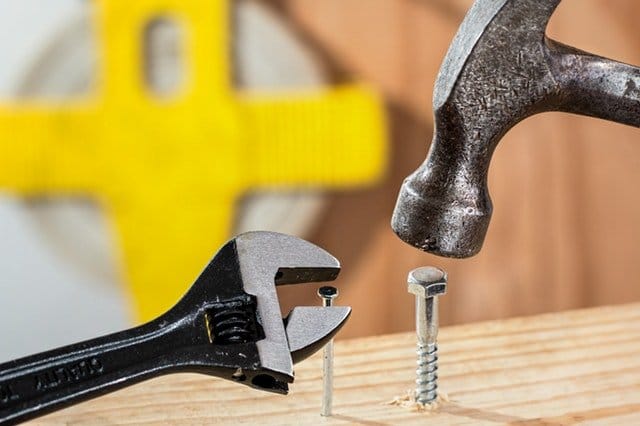
You may have heard of the saying – if you only know how to use a hammer, all problems will appear like a nail. Think about it. You can actually use a hammer in novel ways or you can learn new tools. Food for thought.
8. Learn how to improvise while working
Improvisation is the ability to create things and solve problems on the fly. In the kitchen, you can improvise by using different ingredients if your usual ingredients are over. Musicians work on improvisation. What they do is learn to quickly implement small ideas in a new arrangement and take musical risks. Improvisation increases your chances of solving a problem, especially if you are stuck. To improvise better, access information within your brain quickly and learn to manipulate the basics of a problem. Use Google to gain new insights into what you didn’t know you didn’t know. Improvising will put you in a position to take micro-decisions while producing your ‘productive output.’ The core of improvisation is snowballing around and manipulating ideas along with readily accessing those ideas.
Once you get into the habit of improvising, you’ll save many hours a month because you won’t need heavy preparation. Improvising gets easier when you can manage your resources well.
9. Manage resources like time, money, software, tools, knowledge, people, and health
What do you think of when I say resources? Time? Money? That’s only the tip of the iceberg. Here is a list of resources you need to account for so you can choose to be in a ready state. A key to increasing day-to-day productivity is to manage your daily resources.
- Phone and laptop charging
- Updated and access to useful apps
- Easy modes of payment and purchases
- Ensured logins so communication is easy
- Knowing where to find what you need
- Food & water, so you don’t die while working
- Space to do what you need to do
- Knowing useful humans
- Ability to ask those humans for what you need
- Time – doing small things there and then
- Time – committing to a future hour in a reasonable capacity
- Backlogs – working on backlogs without ignoring current priorities
- Managing & maintaining your tools – stationary, gadgets, software, utilities, etc
- Your self-notes, to-do lists, and bookmarks need to be in your awareness and up-to-date
- Physical resources – maintain your energy supply with food and nutrition
- Psychological resources – maintain your mental resources by constructively handling current and past problems/issues. Let it not drain your capacity to perform.
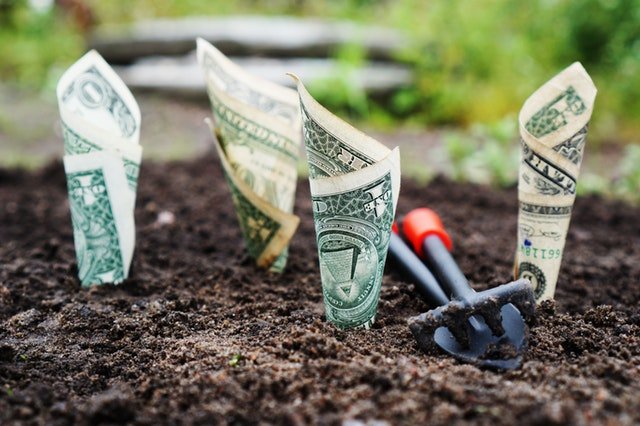
10. Try a variety of options and go through a trial & error phase to maximize your growth and expertise
One of the most fundamental aspects of human learning is based on variations and trial & error. Research on learning has shown that executing a skill well is highly dependent on the variations you experience[13] as well as the amount of trial and error you go through. In fact, variation + trial and error help to differentiate between nuances and train your attention to be flexible. That is a hallmark quality of an expert[14].
If you want to increase your productive output, your capacity to learn and execute has to be high. This increases as you go through variations. Let me explain. Do you want to be a more productive writer? Learn to write a variety of things even if they are unrelated. Want more productivity in your coding skills? Practice and try out a variety of problems. Want to have a useful study session? Expose yourself to a variety of related problems.
Your brain learns to converge on the best approach after it learns the bazillion variations. It also makes your learning and execution adaptive so you can implement things easily in the future. This helps with improvisation too.
Trial & error means spending time trying different solutions with feedback. Remember, you can still be productive even if you fail at something; the feedback allows you to improve. Productivity should be measured by the quality of the process and then the output. Not just the output. Ensuring that the process is rich improves productivity at the output level. Trial and error often results in better solutions and increases the quality of the output when there is no reliable system of work. Focusing only on the output can yield subpar or average outcomes. Try and fail so you can make educated decisions about your work.
11. Make your environment and mental space conducive to productivity
To improve your productivity, you need to take control of your environment and the peripherals. This includes choosing the level of noise, the temperature, clothing, view, the organization of your desk, etc.
Use background music strategically
You can read about the research on music and productivity here and here. The general trend is that complex & stimulating music of your choosing can help when you are doing boring tasks, but it can hurt attention-demanding tasks. Vocal music, because of the vocal frequencies, disrupts attention quickly because our brain is tuned to prioritize the human voice. Some people have different distraction & stimulation (or background noise) preferences, so the choice of music for productivity is quite subjective.
Have a fun and engaging routine with enough flexibility
Life is always in the context of an environment. You can choose to build a part routine, part variable lifestyle. The routine will make you rely on a system that governs your work. People often get fond of routines because they begin to work and yield results. If you lack one, build one. Just make sure that routines don’t become a rut. To prevent making it a rut, allow yourself flexibility, adventure, time-offs, travel, fun, and some time-wasting. Having fun and being in an active good mood is important for work that demands thinking and learning.
Make your mental process slightly more difficult
There is evidence that increasing the cognitive load and construal level can help you do things better as compared to having things too easy. The additional mental effort, at the sweet spot, with enough stimulation and arousal, can help you get done things better. This may even create the “flow state” where you are one with your task and in the “zone” of productivity.
Cognitive load is the total mental resources needed to figure things out. Reading an academic paper to find an answer to a question has a higher cognitive load than accepting the first sentence you see via a google search. The increased cognitive load can bolster your learning and, by extension, productivity.
Construal level is the psychological distance between you and the information. Scribbled notes have a higher construal level than extremely clean notes. Scribbled notes can be more useful for some people. Construal Level is important because obscured information or seeing the vague “big picture” can help you build a stronger network of information in your head, can inspire creative thinking, and can help you develop new perspectives. It’s perfect for ideation and free-thinking.

Modify the design of your environment and remove annoyances
Another aspect of environmental control is designing your space and choosing what works best. Be it an office chair that is better for your posture or keeping a stress-busting bubble wrap next to you. Take control of the peripherals that affect your productivity. One common issue for left-handed schoolchildren is that desks are often designed for right-handed people. This physically kills the left-handed person’s ability to perform at maximum capacity. There are many more issues such as clothes and shoes that don’t fit you well. These extra annoyances can cumulatively hamper your baseline. Keep your tools and utilities ready and accessible too, so the barrier to getting things done is minimized.
Get comfortable in your clothes and adjust the room’s temperature
Studies show[15] that office task performance increases with temperatures up to 21-22° C, and decreases with temperatures above 23-24° C. The highest productivity is around 22°C. However, women tend to be more productive at slightly higher temperatures, and the gain in their productivity is higher than the loss in men’s productivity as the temperature rises to approximately 29° C. At around 30° C, men and women both lose up to 9% productivity. Clothing comfort plays[16] a role, too; a study suggests that exam performance is better if the test-taker is physically comfortable. Overall, comfortable clothes that match your co-workers’ attire are best for productivity inside a company. Otherwise, it’s either dress for comfort/utility or dress to adopt a mindset. Read more on that here.
Choose the best tools, customize them, and use them optimally
Taking control of your environment to increase productivity also includes small micro-adjustments such as customizing your phone, mouse, and laptop to better suit your needs. Customizing and organizing the computer is very useful for those who need to use the computer often. Graphic designers, sound engineers, writers, coders, etc. can all save a lot of time and reduce redundancies by taking control of their interfaces. Even arranging files in relevant folders so you can access them better, organizing your workstation to suit current needs (as opposed to long-term needs), etc. can save a lot of effort. All are about taking control of your environment – the digital one.
Include nature in your environment
Connecting with nature is great for your mental health and overall well-being, even productivity. This is because of our innate tendency to have a better existence when we are in touch with nature – a phenomenon called biophilia. If you are working/studying in a windowless or rather dull room/space, having an indoor plant[17] may improve productivity, reduce stress, and increase attention levels.
12. Set things in motion for productive benefits in the future
The world is extremely fast and interconnected. That shouldn’t pressurize you. That should tell you that you can leverage each interconnected aspect in useful ways. Setting things in motion is about doing something today that will yield results in the future because you can control many variables.

Here is a simple tip: If you have no clear picture of what you want to do productively, do something. However little. Get started on the smallest steps. You’ll then be in the zone to see things happen more clearly as you journey through the steps.
If you have no clear picture of what you want to do productively, do something. However little. Get started on the smallest steps. Share on X13. Set modest consistent targets to increase productivity
Trying to improve 1% at a time is reasonable. It is small enough a target to hold as a goal and achieve it. You’ll realize quality is often hampered by personal expectations that are unrealistic. Be incremental in increasing your productivity.
Knowing your limits is important. But it is also important to mildly push yourself to improve your limits. When you set incredibly ambitious targets, most people tend to disappoint themselves because they are too ambitious. If you set targets that are too low, you are accepting poor-quality work. So what do you do? Not much. Just 1% at a time. You assess your capacity based on your previous experience and incrementally improve your work productivity, quality, and targets by 1%. That is it. 1% at a time. Do this consistently, and you’ll see the magic.
You’ll grow by 80% in a year if you can improve your productivity by just 1% once a week.
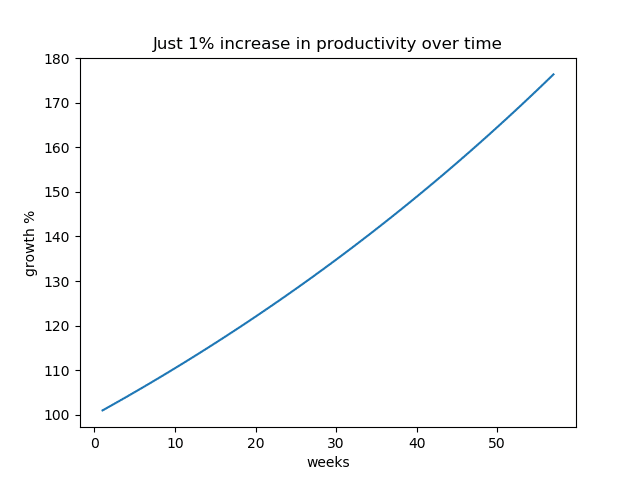
You’ll grow by an astounding 3900% in a year if you can improve your productivity by 1% every single day. Of course, that’s unrealistic because there are limits like time, money, and energy.
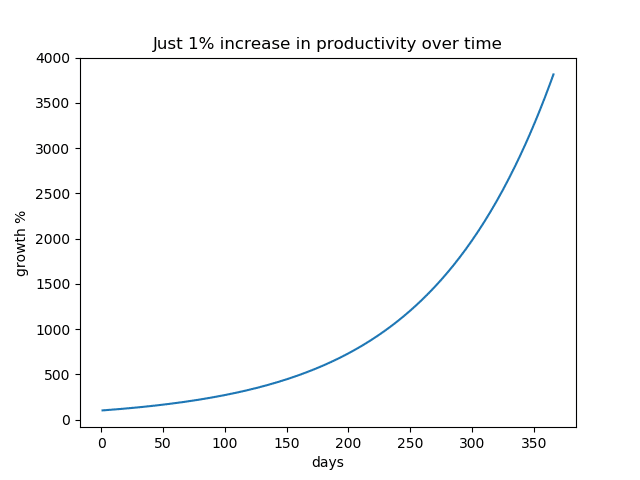
Anything in between is quite reasonable. Apply these growth trends to everything like attention, concentration, study material, emails, reading, time spent on coding, exercising, and outcomes like the number of tasks completed.
1% increase in productivity is a modest and reasonable growth target. Consistency over time is what makes you grow extraordinarily. Share on X14. Use the concept of diminishing returns to know when good is good enough
This may be the hardest-to-master tip to increase productivity. When is “good” good enough? When is an idea actionable enough to implement? When is your write-up polished enough to publish? When is your background homework enough? We have to draw a line around the point of diminishing returns. That is when your effort no longer yields enough value to improve the quality or performance significantly. Or, if dramatic increases in the effort have only negligible benefits.
15. Ask the ultimate question “Is what I am doing useful in any way?”
When do you deem something as useful? The following criteria are a non-exhaustive list:
- Adds value to yourself
- Adds value to someone else
- Makes an investment for potential use in the future
- Relaxes you
- Prevents a compromise of your physical and mental health
- Prevents a comprise of your personal, professional, and social relationships
- There is some future utility to what you are doing
- It makes you feel good
- You can call it awesome & gratifying
- Taking a step backward if it helps accelerate future steps
When is it not useful?
- When one useful aspect compromises something else that is useful – like relaxation makes you miss an important deadline
- Doesn’t add value to you in the long term
- When you do something for money, it takes a long-term toll on your mental health and disables you from coping healthily
- When short-term gratification is actually a 100 steps backward in the wrong direction
These points aren’t about holding a positive attitude. Use really is about utility: does your action have a value-adding aspect to it? It isn’t hard to answer but humans tend to overlook this core aspect of productivity.

How to increase productivity (Infographic)
This infographic is your cheat sheet on how to improve productivity. Do share it, pin it, tweet it, or print it to your liking!
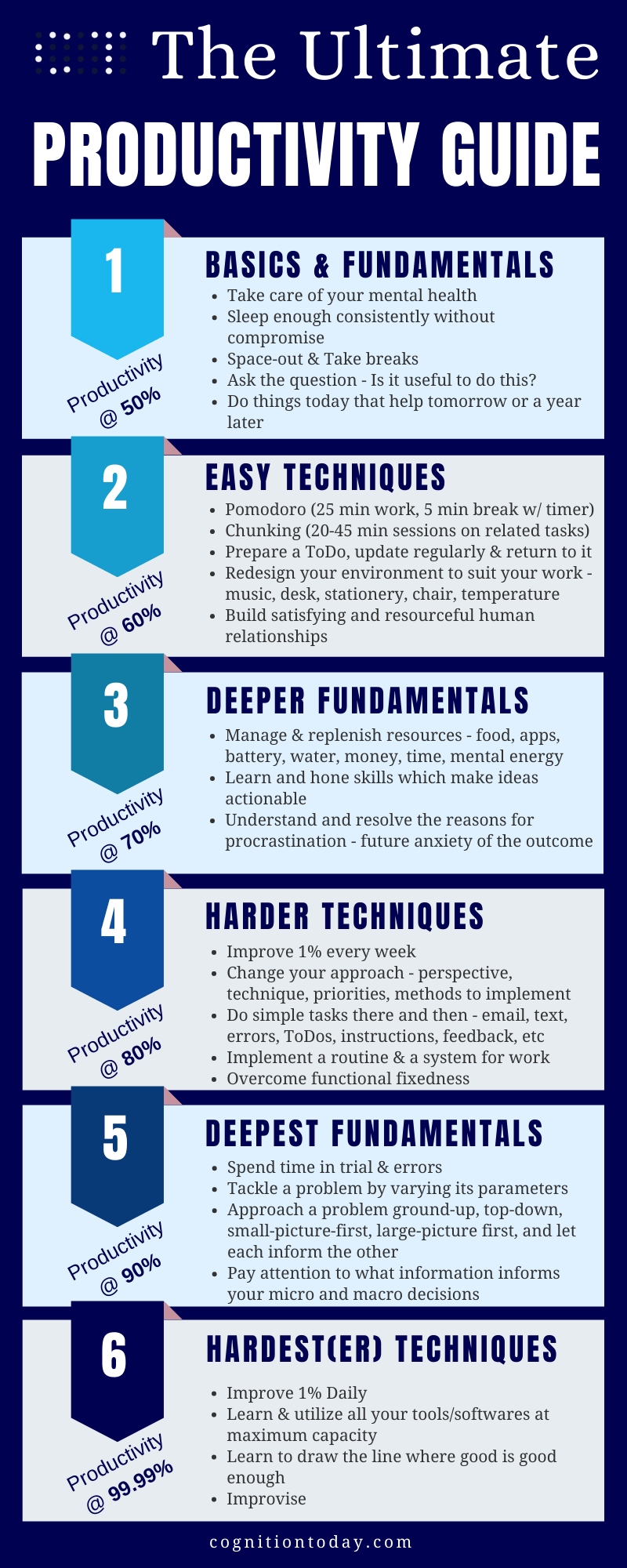
How to be productive: Simple actionable tips to increase productivity
These actionable productivity tips can be implemented quickly and have long-term benefits.
- Dedicate time for physical and mental restoration.
- Keep resources ready and available.
- Understand the law of diminishing returns.
- Do small things there and then such as texting, appointments, quick edits, etc. If there and then is not possible, aim to make it possible. Piling up is a psychological burden you do not need.
- Prioritize mental health.
- Be reasonable with your capacity to achieve a target. Try to do just a little extra. Overkilling and under-killing both have detrimental effects.
- Regularly filter your actions with the question – Is it useful?
- Assess the value of effort in creating productive outputs.
- Value the effort as long as it helps you learn, solve problems, or eliminate hurdles.
- Try and keep trying with variations in your approach. Add variations to the problem itself.
- Make errors at minimal costs and learn from them.
- Build useful relationships.
- Do not compromise on a healthy sleep routine, seek help if you can’t sleep well enough.
- Use designed strategies if they are better than what you are used to such as efficient study methods for studying or a system to write code.
- Overcome functional fixedness and learn to improvise by using your resources in unorthodox ways.
- Learn when to go DIY and when to outsource or automate.
- In case you are really low in productivity, make sure you actually possess actionable, executable skills to become productive. It ain’t going to happen magically.
- Be comfortable in your shoes. Literally. Dress appropriately for the work at hand.
This sums up the ultimate guide to increasing productivity. We haven’t relied on borrowing successful people’s habits. We have looked at factors and tips that will make you a productive person by addressing the fundamentals.
Now you can build a framework that can make you a productive person. I’d love to hear about how well you do after addressing these factors!
Sources
[2]: https://psycnet.apa.org/record/2017-23694-005
[3]: https://psycnet.apa.org/buy/2001-05924-006
[4]: https://www.ingentaconnect.com/content/png/ajhb/2004/00000028/00000005/art00007
[5]: https://www.journals.uchicago.edu/doi/10.1086/681096
[6]: https://pubmed.ncbi.nlm.nih.gov/28823195/
[7]: https://www.sciencedirect.com/science/article/abs/pii/0022103167900297?via%3Dihub
[8]: https://link.springer.com/article/10.3758/BF03210823
[9]: https://psyarxiv.com/3uk2b/
[10]: https://link.springer.com/article/10.1007/s11031-016-9541-2
[11]: https://journals.sagepub.com/doi/abs/10.1177/0146167211432763
[12]: https://psycnet.apa.org/record/1951-07923-001
[13]: https://www.tandfonline.com/doi/abs/10.1080/07370008.2015.1067215
[14]: https://www.sciencedirect.com/science/article/pii/S2211368115000388
[15]: https://escholarship.org/content/qt45g4n3rv/qt45g4n3rv.pdf
[16]: https://onlinelibrary.wiley.com/doi/abs/10.1177/1077727X04274115
[17]: https://www.researchgate.net/publication/237441131_Interior_Plants_May_Improve_Worker_Productivity_and_Reduce_Stress_in_a_Windowless_Environment

Hey! Thank you for reading; hope you enjoyed the article. I run Cognition Today to capture some of the most fascinating mechanisms that guide our lives. My content here is referenced and featured in NY Times, Forbes, CNET, and Entrepreneur, and many other books & research papers.
I’m am a psychology SME consultant in EdTech with a focus on AI cognition and Behavioral Engineering. I’m affiliated to myelin, an EdTech company in India as well.
I’ve studied at NIMHANS Bangalore (positive psychology), Savitribai Phule Pune University (clinical psychology), Fergusson College (BA psych), and affiliated with IIM Ahmedabad (marketing psychology). I’m currently studying Korean at Seoul National University.
I’m based in Pune, India but living in Seoul, S. Korea. Love Sci-fi, horror media; Love rock, metal, synthwave, and K-pop music; can’t whistle; can play 2 guitars at a time.




























Thank you so much for sharing this. The content is very helpful and I have definitely gained some nice insight from the tips shared!
Thank you 🙂 I’m glad you gained insights 🙂
The post that you have shared is quite informative. I personally use a time tracking app to stay organized and productive at my workplace. if you are looking for any tool to manage your time better, try time tracking software. Super easy to use and really cost-effective as well.
Great web site you’ve got here.. It’s hard to find good quality writing like yours these days. I really appreciate people like you! Take care!!|
Very interesting! You mention several researches. Maybe I overlooked, but can I find those researches you are referring to anywhere? I am looking for more references in the visual memory Where do i get more references
Thanks! The hyperlinks (dark blue, not the dotted underlined ones) will either take to one of the site’s articles which has original paper citations or take you to the original paper directly. I can help you find papers if you’d like. What exactly are you looking for?
Good site you’ve got here.. It’s hard to find excellent writing like yours these days.
I tuly appreciate people like you! Take care!!
Thank you so much for your kind comment:)
Hey, this was a super helpful! Guilty of completion anxiety. So time to print that infographic! Thank you!
Thank you, I’m glad it is useful to you:)